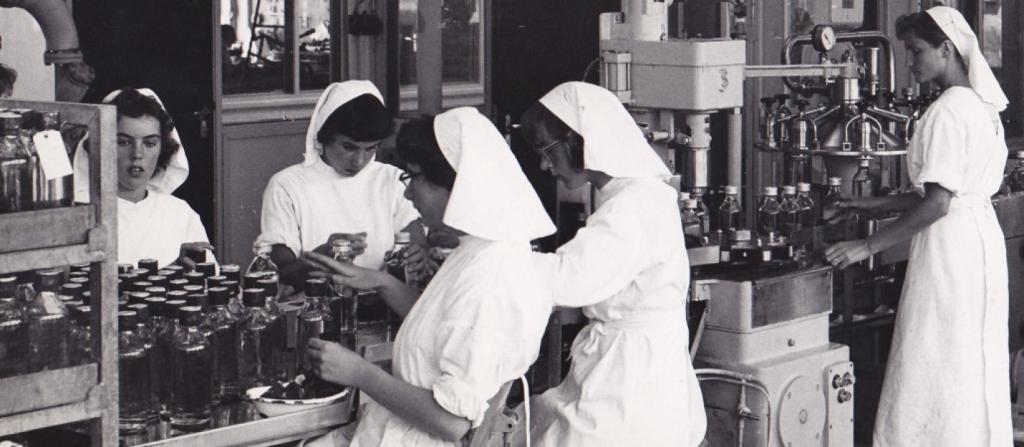Our history

While the Sanquin Blood Supply Foundation officially came into being in 1998, the very first stirrings of a blood transfusion service in the Netherlands trace back to 1930.
Even in ancient times, the fundamental importance of blood for life was understood. It's no wonder blood has been used for millennia in rituals, as a sacred relic, or as a form of medicine. Yet, it wasn't until relatively recently that the Netherlands established its own dedicated blood supply, with the first transfusion service emerging in 1930. Others soon followed, eventually merging in 1998 to form the Sanquin Blood Supply Foundation. Let's journey back through the pivotal moments in our history.
The earliest attempts
The first documented attempt at blood transfusion occurred on June 15, 1667, and sadly, it didn't end well. The blood came from a lamb, and neither the animal nor the patient survived. It became clear that animal blood wasn't compatible with human blood. In the same year, the first human-to-human blood transfusion took place. While sometimes successful, outcomes were far from guaranteed.
The discovery of blood groups
Fast forward to 1900, a landmark year thanks to the insightful work of Austrian physician Karl Landsteiner. He observed distinct structures on the surface of red blood cells – some present in one person, absent or only partially present in another. This led to the ABO blood group system. Suddenly, the mystery of why some patients reacted severely or even fatally to donor blood was solved: they had received blood from an incompatible blood group. When Landsteiner further identified the rhesus D blood group in 1940, the safety of blood transfusions took a giant leap forward.
Inspired by a British model
In 1921, Sir Percy Oliver of the British Red Cross pioneered the first blood transfusion service. He championed the principles of voluntary, unpaid blood donation, available to all in need, regardless of who they are. This was a brilliant blueprint, recognized by Dutch internist H. van Dijk, who established the first Dutch blood transfusion service in Rotterdam in 1930, adhering to the very same principles. This example quickly spread to other cities across the Netherlands. The looming threat of the Second World War provided an added urgency to recruit blood donors. By 1940, the Netherlands had 28,000 registered donors. Two crucial 'preservation facilities' were also established to maintain blood stocks for emergencies. Tragically, the Rotterdam facility was bombed in May 1940. The Amsterdam facility, however, expanded its operations and even developed a plasma drying installation to supply vital freeze-dried plasma to war victims.
From 110 to 22 blood banks
In 1943, the Central Laboratory of the Blood Transfusion Service (CLB) emerged from the Amsterdam preservation facility. Its core tasks were determining blood types of donated blood and producing medicines from blood plasma. The CLB increasingly focused on diagnostic and scientific research, becoming the Netherlands' leading knowledge center in the field of blood by the 1950s. Meanwhile, across the country, 110 blood transfusion services had sprung up, responsible for screening donors, collecting blood, and managing local supplies. Recognizing the benefits of collaboration, these services gradually consolidated, culminating in 1973 with the formation of 22 regional, independent blood banks.
The birth of Sanquin
Despite this consolidation, the 22 blood banks still operated autonomously. This independence sometimes led to inconsistencies in the quality and uniformity of blood products. Furthermore, tensions arose between the CLB and the blood banks, particularly concerning the CLB's own plasma collection activities and the agreed-upon pricing structures. Recognizing the need for greater cohesion, Els Borst, minister of Health, Welfare and Sport, intervened. In the mid-1990s, she commissioned research into how the Netherlands' blood supply could be better organized. The answer: bring all parties together under one centrally controlled organization, accountable to the government. And so, on January 1, 1998, the CLB and the 22 blood banks merged to form the Sanquin Blood Supply Foundation. Since then, alongside its core activities of collecting, processing, and distributing blood products, Sanquin has been actively involved in conducting research, providing education, and offering diagnostics.
Name and pelican
The name Sanquin combines the French word for blood (sang) and its Latin equivalent (sanguis). Our logo, the pelican, is a nod to the very first blood transfusion service in Rotterdam, established in 1930. Since the Middle Ages, the pelican has stood as a powerful symbol of altruism and compassion. Legend has it that a Dalmatian pelican would pierce her own breast to feed her hungry young with her blood – a poignant symbol, we believe, for the selfless blood donations of our contributors.
Today, Sanquin is deeply rooted in Dutch society. While we've undergone significant internal reorganization, our fundamental social mission remains steadfast: saving and improving lives, together with our dedicated donors, by providing safe blood products to patients and conducting groundbreaking research into blood-related diseases.